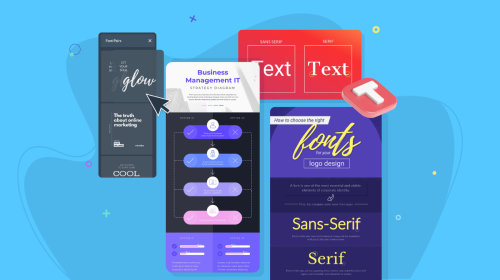
What Is a Mockup & Why Do You Need One


Creating professional-looking mockups is a crucial task for any marketer or business owner. This is because mockups help communicate your product design ideas with co-workers, investors or clients in a visual way. And they’re also incredible visual marketing tools.
But what is a mockup exactly and how can you create one if you’re not a professional designer? Well, we have the answers to all of that.
In this article, we’ll cover what a mockup is, different types of mockups, why mockups are important and more.
We have a lot of material to cover here, so let’s get right into it.

A mockup is an artistic rendering of a design or product that showcases said product in action. A mockup can be a model, image or scene of a proposed design or product, and they’re often used for demonstration, education or promotion.

The concept of mockups has been around forever and can be created in many forms, such as being hand-drawn or physically constructed.
But nowadays — big thanks to technology — you don’t need to be a professional artist or spend countless hours drawing up your mockup.
You can now create a mockup within minutes and save precious time, energy and money by creating your mockup quickly with an online tool.
By using mockups, you can avoid unspoken assumptions and confusion by solidifying with your coworkers and clients, in detail, what the finished product or design will or could look like before you even begin the actual creation process.
You can also use mockups to share product ideas or renderings with customers so they have a better idea of what they’re buying before they make a purchase.
If you’re interested in how you can make a professional mockup in just a few easy steps, we have an entire guide dedicated to the subject.
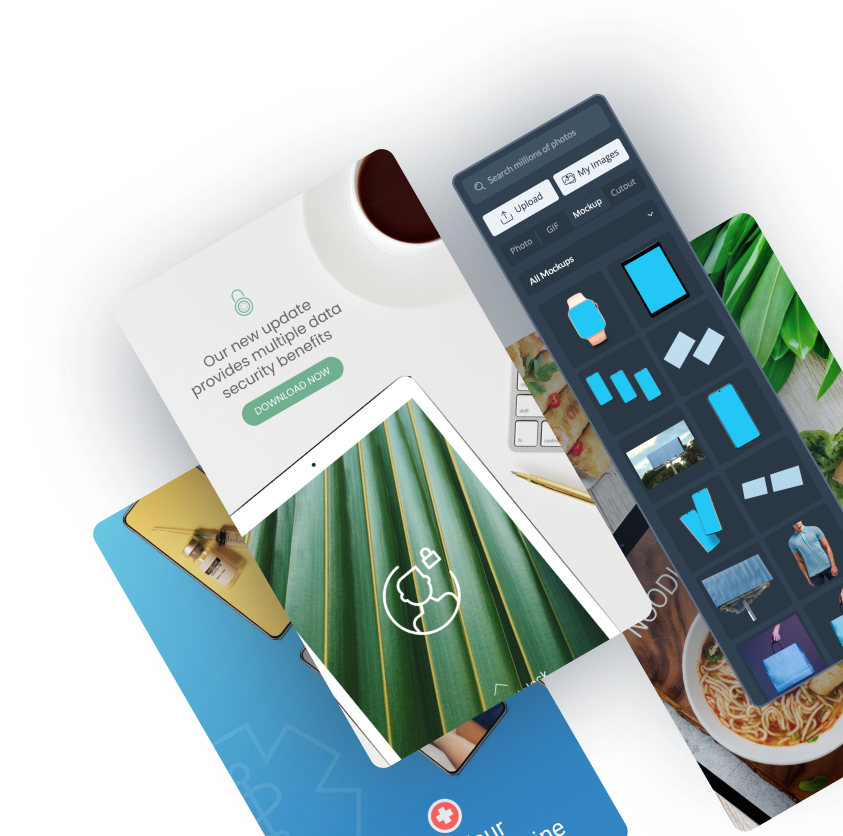
When creating a website or app, you'll often hear the terms "mockup," "wireframe" and “prototype.” They are all essential for the development process, but serve different purposes.
What they do, though, is create a design process flow for web and app design: Wireframes establish the structure during planning → Mockups add visual details → Prototypes help with user experience.
In the table below, you can see how they’re different and the best time to use each one.
Both wireframes and mockups are important in the design process. Wireframes establish the structure, while mockups add visual details. Designers use both to ensure that the final product is functional and looks good.
| What is it? | Visual Characteristics | Primary Purpose | When to Use | |
| Wireframe | A basic layout of a webpage or app screen that shows the structure and placement of content and elements. | Black and white, lacks detailed visuals. Resembles a blueprint. | Focuses on placement and flow of content without visual distractions. | Early design phsare to establish structure and layout. |
| Mockup | A detailed visual model of a webpage or app screen with realistic preview elements, or a visual rendition of a product with a logo or design on it. | Includes colors, fonts and images in a composition resembling a finished product. | To show design stakeholders and get feedback, or create marketing visuals for sales and lead generation. | Before or during development, and during sales and lead gen campaigns. |
| Prototype | Working rendition of websites or apps with interactive elements. | Includes interactivity, navigation and functionality. | To conduct user testing and user experience analysis. | User testing phase to validate functionality or to show stakeholders the design progress. |
Across all industries, mockups are useful and informative for product visualization before production.
Because of the large variations in industry needs, there are many different types of mockups:
We’re going to do a deep dive into some of the most common types of mockups so you can see which one will best suit your industry’s needs.

A print mockup is a photorealistic rendering of potential print material and can be used to visualize how it will look after being printed.
By creating a print mockup, you can visualize your design on flyers, banners, postcards and nearly any other printed material.
Aside from verifying the overall design layout, print mockups can help verify the legibility of the font size prior to printing.
Print mockups can save you time, stress, money and even help save the environment by testing and sampling design ideas.
Furthermore, print mockups are perfect for creating visuals of your lead magnets, ebooks and other printable marketing materials. Don’t use a boring screenshot of your cover page; instead, create an eye-catching mockup that increases downloads and lead generation.

A device mockup is a photo rendering of an electronic device where the screen of the device, such as a phone, tablet, computer screen or smartwatch, can be replaced with your design.
Device mockups are useful in marketing because you can show off your app or web pages in visually appealing designs, rather than sharing a boring screenshot.
This type of mockup is also great for tech companies in the development phase to assist in deciding what their app or webpage will look like.
For small startup tech companies, a device mockup can help them save money on development for a season and allow them to focus on other tasks such as research and marketing.
If you’re looking to develop your new app idea, we have free educational guides on how to design and develop your own apps that will help you get a jumpstart on your creative endeavor.
Website mockups are essential for sharing web designs with clients and stakeholders during the development processes. There are several ways you can share a website inside a mockup. One is with a screenshot of what the website looks like and another is using a tool like Figma that shows the entire website with a scrolling function.
I spoke with a web designer friend, Nick Culic, to learn about his design process and asked how he shows website mockups to his clients. Here's what he said:
"Visually presenting website design mockups lets clients not just see the design, but also see it in context. A PDF will show you the whole thing all at once, but you never actually see a website like that. And that's so important because clients will ask for inconsequential changes when they don't understand exactly how the design will work. For example, I've had a client say 'there's too much blue' when looking at a PDF of the design, but when I show them the mockup in context, they realize it's actually not too much blue and it looks and works amazing."
In the section below about the best mockup design tools, I share a short video from Nick showing how he uses Figma for both his web design and mockup needs. Here’s a sneak peek.
You can easily create a static website mockup with Visme using a screenshot of the website in question. Here’s a quick GIF that explains how to do it:

And here is a real-life example of a website mockup from a web designer on Behance:
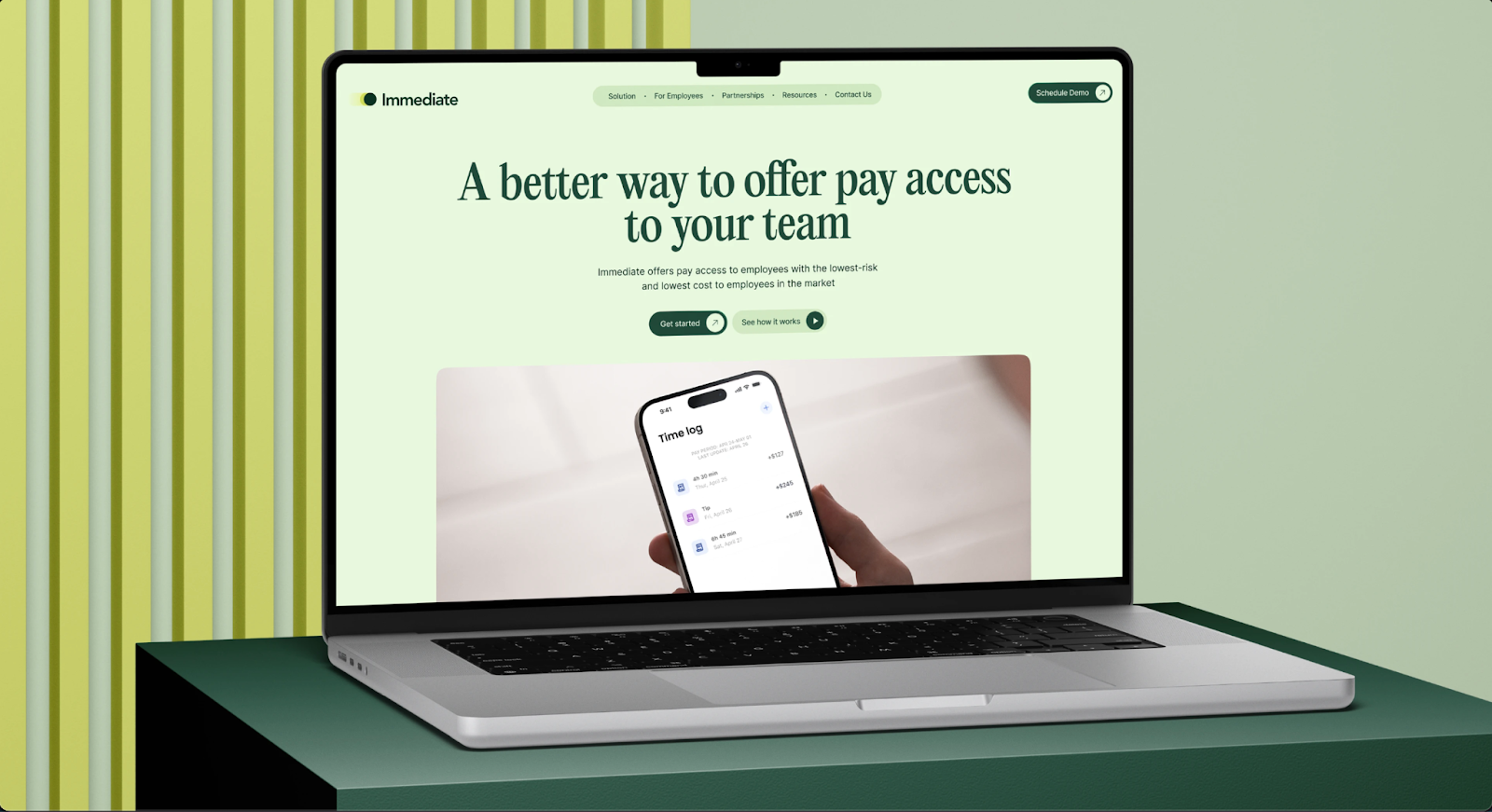
Source: Behance

A branding mockup is an image rendered with a company’s logo, motto or other branding material on commodity products.
You can create awareness and fidelity for your brand by branding things such as notepads, cups, pens and other various objects.
Branding mockups can be useful for businesses that are considering starting a new marketing campaign. For example, consider a scenario where a local business has set aside a small amount of money for advertising.
Before a decision is made to spend the budget on a random assortment of branded objects, the business owners could be shown some branding mockups to help them decide on what particular items to brand.
Branded items do not have to be strictly related to the company's main products.
For instance, a small local restaurant sells food, but they may also sell/give away pens with their logos on them.
Although the restaurant has little to do with writing, by placing their logos on pens they are able to make their brand known and remembered by customers.
Branding mockups let you visualize these designs and see which ideas are suitable for your company’s needs.

A packaging mockup is a photo representation of your branding placed on various packaging items. This may include boxes, plastic bags, paper bags and other various packaging materials.
In marketing, the packaging of an item is much more than just a means of sending your product in a box or bag.
Packaging an item sends a subliminal visual message to your clients regarding the quality of the item inside of the package.
A packaging mockup can help tremendously in producing quality packaging.
Which font size, font color, background color and material to use are all questions that will naturally be answered by creating a packaging mockup.
Creating a mockup will help you come up with a branded packaging that is consistent with your company's values and create an unboxing experience that is sure to leave a lasting impression on your customers.

A product mockup is a realistic digital rendition of a product design. It’s typically used at the start of a new project to help a team capture a vision for the end result of a product design.
Product mockups have also been used in advertisements. For example, many E-commerce stores opt to use t-shirt mockups by importing their design onto a mockup template, as opposed to photographing each shirt individually with all its variations.
Using mockup templates makes the design aspect of the mockup incredibly easy. If you are looking for free t-shirt mockup templates, hoodie mockup templates and other product mockup templates, check out Visme’s mockup generator.

A social media mockup is a digital rendering of various social media sites that allows you to insert and visualize your content before posting it to the official media site.
Considering that nearly 55% of all internet traffic is generated on mobile devices, it is important that your images, videos and posts have proper proportions for mobile devices.
Social media mockups are a great way for businesses and brands to check the proportions of their posts and ensure they are properly formatted and responsive for all types of devices.
Additionally, social media mockups can be valuable visuals to include within blog posts, marketing plans or even shared on social media.
To ensure that your social media posts are the best they can be, check out our guide on how to create professional posts for social media.
The final mockup type you should be aware of is billboards and signage. These are essential for large-scale design projects for Out of Home marketing, store fronts and even wayfinding.
Visme offers several billboard templates and you can find signage and wayfinding mockups online.
Here’s an example from a site called Mockup.Maison which sells mockup packages for professional designers.

Likewise, here’s a street banner mockup from mockups-design.com.
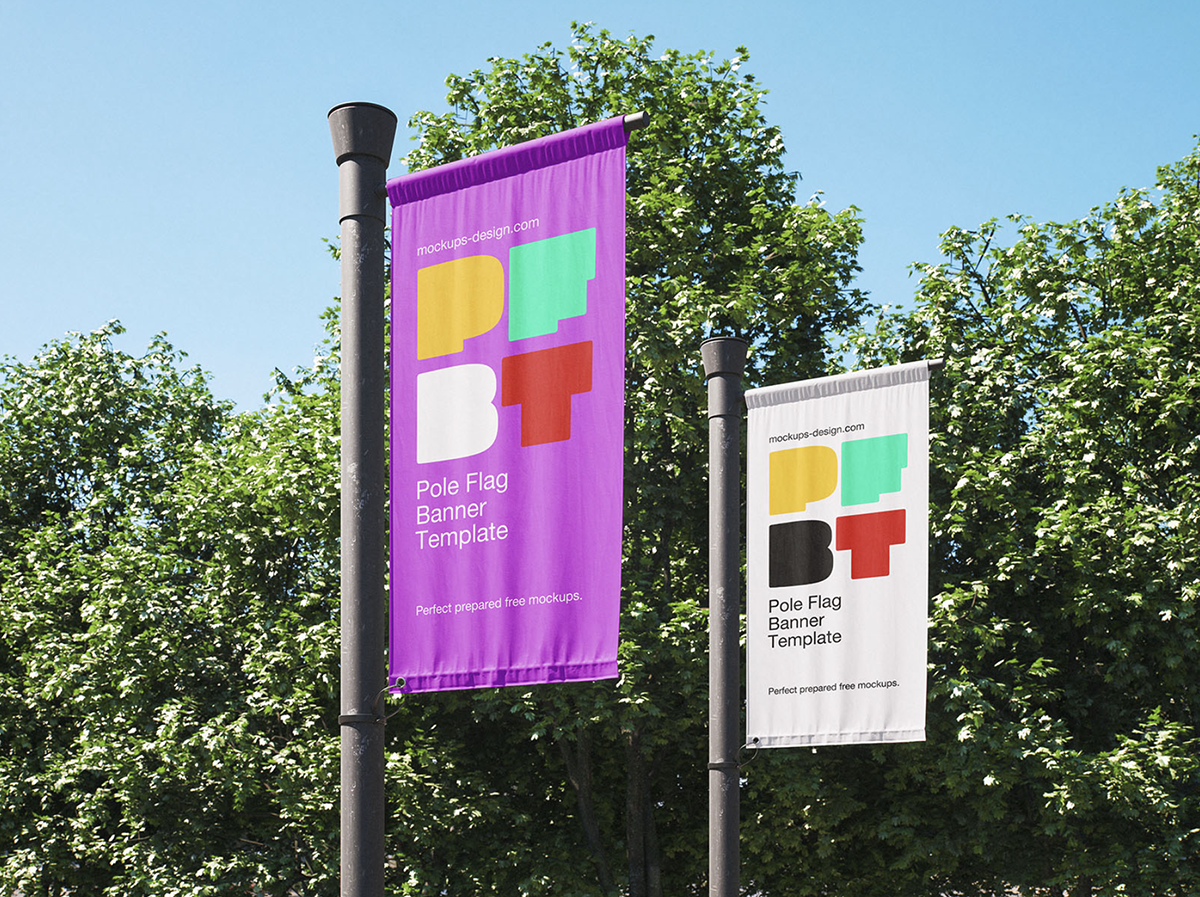
Mockups give your audience a clear visualization of what you’re creating or selling, be it a web design in progress or an ebook lead magnet.
Since over 65% of the world identifies as a visual learner, it’s a good idea to create visual aids, such as a mockup, to share your ideas and products.
Mockups can be used in any department, from marketing to design, board meetings to R&D.
Graphic designer Tomisin Ezequiel, shared this sentiment on LinkedIn,
“A design on a flat screen is nice…But when you see it on a product, billboard, or packaging, it feels different. It feels real. That’s why I use mockups. They help you picture how your brand will actually look in the hands of your customers. No guesswork. No confusion. Just clarity.”
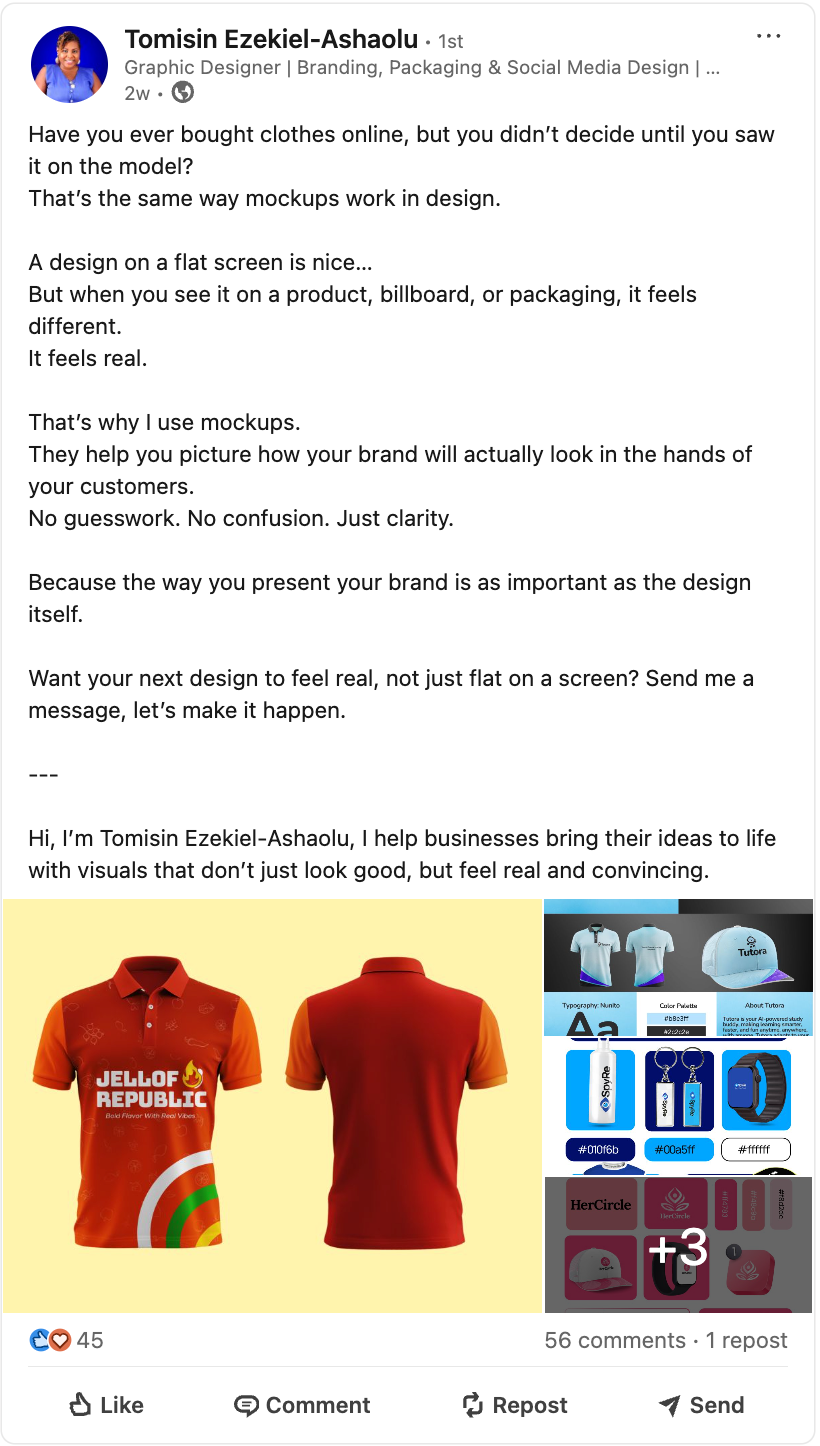
Source: LinkedIn
Now, let’s take a look at the benefits of using mockups and their impact in different scenarios.
| Action | Benefit | Use case/Scenario/Team | Impact |
| Visualize an end goal | Show what the final product will look like before or during the development process. | Design teams presenting to stakeholders or during project planning meetings. | Reduces miscommunication and ensures everyone shares the same vision. |
| Help unify a team | Creates a shared reference point for all team members to work toward. | Cross-functional teams, remote teams and development handoffs | Improves collaboration and reduces back-and-forth revisions. |
| Get investors on board | Demostrates product potential with tangible visual evidence. | Pitch meetings, funding presentations and board meetings. | Increases likelihood of securing investment and support. |
| Expand a library of marketing assets | Creates reusable visual content for various marketing channels. | Marketing teams, social media campaigns and website galleries. | Builds brand consistency and professional presentation materials. |
| Engage audiences | Demonstrates attention through visual storytelling instead of text-heavy descriptions. | Social media posts, landing pages and email campaigns. | Increase engagement rates and time spend viewing content. |
| Improve lead generation | Converts prospects by showing rather than just telling them what they’ll receive. | Sales presentations, product demos and landing page offers | Higher conversion rates and qualified lead capture. |
| Inspire purchasing decisions | Helps customers visualize owning or using the product. | E-commerce listings, product catalogs and sales materials. | Reduces purchase hesitation and increases sales conversion. |
Even though mockups are super versatile and work across lots of different contexts, they’re not always the right choice.
For instance, designer Allesando Giammaria shares in his Medium article,
“Mockups are a tool, not the end goal. Our objective as designers is to communicate an identity, tell a story, solve a problem. Mockups should support this mission, not distract from it.” So, following this sentiment, always consider if you really need that mockup, or that many mockups make sense inside your presentation or digital document.
In some cases, they can even distort the perception of your work if there are too many of them or if they’re too elaborate. Product designer Tina Golub, shares her personal view on why she stopped using mockups:
“Around 87% of desktop computers and laptops around the world run on Microsoft Windows, yet most design mockups are shown on the latest Mac. It might be aesthetically pleasing to see your design on the latest iPhone, but there is a good chance your users are looking at it on a cracked screen of their second-hand smartphone, and they are seeing a very different picture. Just as it is important to design for the smallest device with the lowest brightness and the slowest internet connection and ensure your product remains usable, showing it on the latest smartphone defeats the very purpose of a design mockups — that is to show your work in context.”

Investors have also seen the benefits of mockups. By creating a customized mockup, potential investors can visually connect with your ideas.
A clean, sleek and professional-looking mockup can help get investors on board and invested in your product.
If you’re considering creating a pitch deck to present to potential investors, then you should consider adding a few mockup images to take it to the next level.
If you want to learn more on how to create the best pitch deck, we’ve written an entire guide just for you that can help you accomplish that.
When it comes to creating mockups, having the correct tools for the job can make or break the experience.
Here are the best mockup software tools for creating customized mockups and a brief description of why we think they are the best.
| Mockup Tool | Key Features | Pricing | Best for | Core Uses | G2 Rating |
| Visme | Drag and drop interface, hundreds of templates, AI tools, collaboration, branding options, interactive elements. | Free plan available; Starter $12.25/month, Pro $24.75/month, Enterprise (contact sales) | Beginners and experienced designers seeking ease of use | High-fidelity mockups with minimal effort, team collaboration | 4.5/5 (450+ reviews) |
| Mockey AI | 10,000+ templates in 45+ categories, 3D and animated mockups, AI-powered customization, no watermark downloads | Free plan; PRO $5.70/month, MAX $15.20/month, Lifetime $199 | Product mockups (apparel, accessories, packaging) | E-commerce product visualization, print-on-demand | 4/5 (5+ reviews) |
| Figma | In-app prototyping/mockup feature, real-time collaboration, extensive plugin library, web-based platform. | Free plan; Professional $16/month, Organization $55/month, Enterprise $90/month | UI/UX designers and development teams | Website and app mockups, interactive prototypes | 4.7/5 (1700+ reviews) |
| Freepik | Integrated online mockup editor, AI mockup generator, extensive template library, PSD downloads. | No free plan. Essential, Premium, Premium Pro, Pro |
Designers needing diverse mockup styles | General design projects, various mockup categories | 4.7/5 (140+ reviews) |
| Placeit (Envato) | Simple online editor, social media/e-commerce integration, business cards, apparel, digital devices. | $7.47/month for unlimited downloads | Quick mockup creation without learning curve | Social media content, e-commerce listings | 3.7 /5 (95+ reviews) |
| Adobe Photoshop | Smart Objects, layers system, 3D mockups, extensive customization, industry-standard tools. | Individual $22.99/month, Business $37.99/month | Advanced users needing detailed customization. | Professional mockups requiring pixel-level control. | 4.6/5 (13150+ reviews) |
| Media Modifier | Online editing, PSD downloads, custom mockup requests, social media focus, mockup API. | Free plan; Professional $12.50/month, Team $27.50/month | Social media marketers and e-commerce businesses. | Social media mockups, signage, unique products. | N/A |

G2 Rating: 4.5/5 (450+ reviews)
When it comes to easily creating a high-fidelity mockup of your design with the least amount of effort, the best tool for the job is Visme.
Visme has a wide variety of mockup templates to choose from that effortlessly implement your design into the scene.
With a simple drag-and-drop action, you can import your logo or design into the editor and it immediately generates your new professional-looking mockup.

Visme's interface is easy to use. You can easily add and move elements to make design adjustments quickly and seamlessly. You don't need to be a professional to use the tool effectively because the drag-and-drop functionality is simple. This feature saves time, allowing you to focus more on the creative aspects of your project.
Visme offers a variety of professional, customizable mockup templates to help you start projects quickly. These templates are made by experts to ensure high quality. They save time by providing a strong foundation that you can easily adjust to your needs.
Access the vast library of vector icons, 3D animated graphics and illustrations to bring your vision to life with precision. Tweak each element to match your brand's style and color scheme. This flexibility ensures that your designs are unique and tailored to your requirements.

Visme's AI-powered features, like the AI Writer, AI image generator and AI Designer, make the mockup design process even easier. Prompt the AI writer generate creative content ideas and text that fit perfectly with your design.
Ask the AI image generator to create unique visuals tailored to your design without much manual effort. And with the AI designer, quickly create any design with your uploaded content and descriptive prompt.
Use the real-time collaboration options to share your work with team members, gather feedback, and make necessary adjustments quickly. Invite colleagues to view, comment, annotate and live edit your mockups.
Imagine, for instance, that you’re the designer in charge of creating a lead magnet ebook. Another designer, on the web team, is creating a hero image for the ebook’s landing page. Inside the canvas, they design the graphic with a mockup and assign you to place the ebook cover design into the mockup. Finally, the product manager reviews everything and leaves feedback for everyone.
Use Visme's brand design tool to keep your designs consistent with your brand. Just copy and paste your website URL, and the tool will extract your brand colors, fonts and company logo and save them under your brand area.
So, whenever you need to apply your branding to any document, you do so with one click.
Add interactivity to your mockups with clickable buttons, hotspots, hover effects and links to make your designs more engaging. These elements help guide users through your design, enhancing their experience. It's a great way to make your mockups feel more alive and functional.
Likewise, add subtle animations that bring your mockups to life. They'll make your design more interesting and memorable.
Easily integrate data into your mockups with a variety of charts, graphs and data widgets to visually represent complex information and convey data-driven insights clearly. Choose from options like pie charts, bar graphs, line graphs and data widgets like progress bars, radial gauges and population arrays.
Use the editing tools to customize the appearance of charts to match your design. And to share live data, integrate online data sources like Google Sheets and MS Excel into your Visme charts. They will update automatically whenever there’s a change in the source spreadsheet.
Access a vast library of high-quality stock photos and videos to enrich your designs and make them more visually appealing. They save you time by eliminating the need to search for external media. Incorporating stock photos and videos can elevate the aesthetic of your mockups, making them more impactful.
Use Visme's advanced analytics features to see how your visitors interact and engage with your mockups. Track views, average time spent on each mockup, and total visits to gain insights into audience engagement. The dashboard also displays visitors' IP addresses, giving you detailed information on their geographic location.
Visme has a free plan with all the essential features for testing the tool. The paid plans with advanced features, storage space and download options are:
G2 Rating: 4.0/5 (5+ reviews)

Mockey AI is an online AI mockup generator that offers over 10,000 pre-made templates ready for editing with your uploaded image. The template library includes more than 45 different categories, including t-shirts, tote bags, mugs, books, boxes, phones and more.
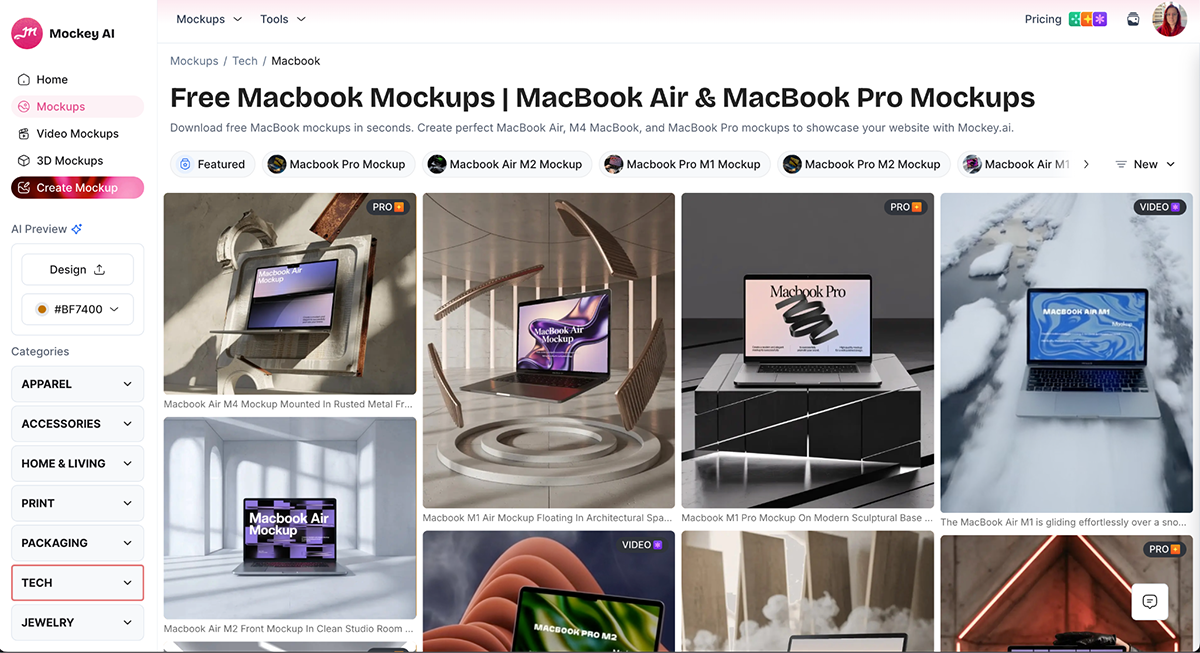
The best way to get started with MockeyAI is to sign up for the free plan.
Just by signing up, you can explore most of the templates, features and tools. Some are labeled as pro and will trigger the paywall to test them. Then, when you want to download your mockup, free plans only get low-res JPEGs.
I signed up for MockeyAI and was pleasantly surprised at all the available options. Aside from the regular static mockups, they also have 3D and animated mockup designs, which you can customize with AI. I uploaded one PNG graphic and when I wanted to see how it looked on another product, I didn’t have to upload it again. The system applied it to the new product automatically.

The screenshot above shows the editor and a mockup I created with a design of a label that I had in my portfolio. It was easy to change the color of the box. Below the image is an AI prompt window that offers lots of optimization options, but you need a paid plan to use them.
Mockey AI offers a free plan that covers many of its design tools to try it out. Paid plans give you more features and better quality download files. They also have a lifetime plan, which is a good value.

G2 Rating: 4.7/5 (1700+ reviews)
Figma is a web-based and feature-rich UI/UX design platform specialized for front-end design and development. It has become an industry standard for the web development community, where teams can work collaboratively in real-time.
Apart from being an online design tool, it's also a good resource for creating mockups, specifically website and app mockups. That said, it works specifically for the designs you create in Figma, so it’s not the best option if you have a design from somewhere else.
Figma offers several options to share a design inside a mockup, and you can choose from different screen types, including several Apple and Android devices like computers, laptops, phones and watches.
Nick Gulic, a web design professional, recorded this step-by-step video to show how he uses Figma to create mockups for a design project.
The mockup tool inside Figma is called Prototyping, so Nick calls it that at the beginning of the video. In essence, a mockup and a prototype are similar, but a mockup won’t have any interactive elements or navigation, while a prototype will.
Aside from their in-platform mockup feature for web and app designs, there are also several mockup plugins designed specially for Figma, which offer other styles and scenes that Figma doesn’t offer natively. Here’s a preview of one of the plugins open in the Figma canvas.
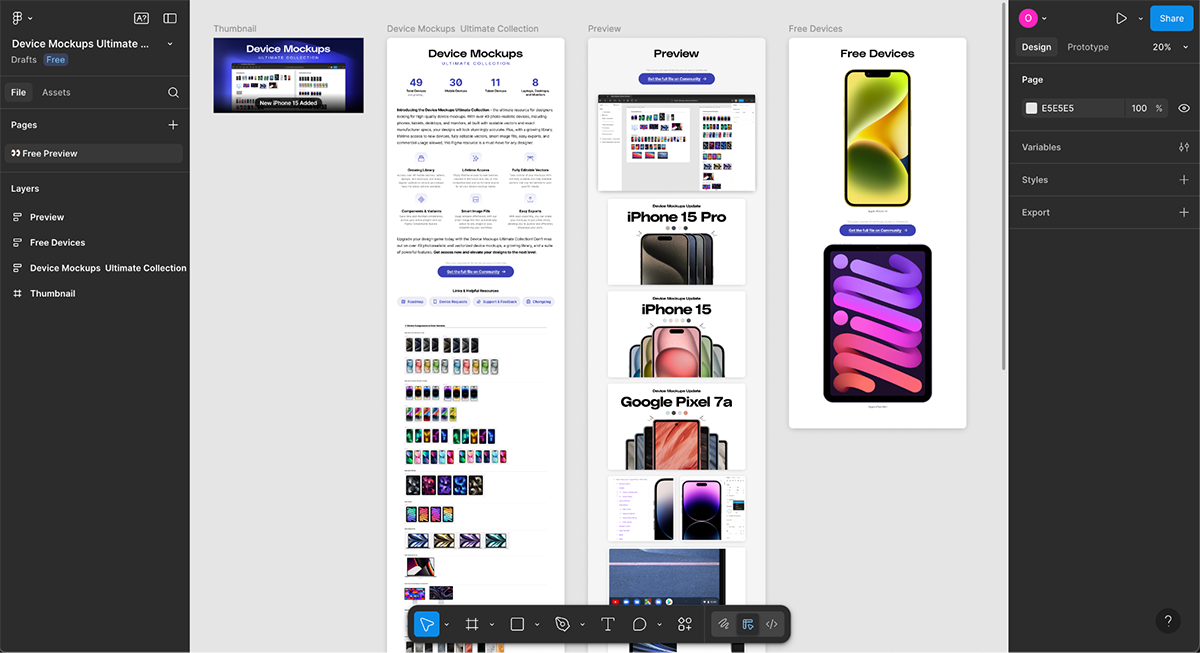
The idea is that you pull the device you want out of the collection and place your design inside it. This is more manual than the integrated mockup feature.

G2 Rating: 4.7/5 (140+ reviews)
Freepik is a comprehensive resource hub for designers, offering an extensive collection of mockups that can be edited online using their tool or downloaded and edited with Photoshop.
Their mockup library contains thousands of templates that cover a wide range of categories and styles.
The integrated Mockup Editor helps you create and edit mockups directly online without needing external software. There aren’t many free options, though; most are under their premium plan.
Here’s a screenshot of a tote bag with one of my designs placed on it. I like that you can easily change items in the visual, like the bag handle and even the stitches. Furthermore, you can use their AI agent to generate new mockups for whatever you need just by writing a prompt.
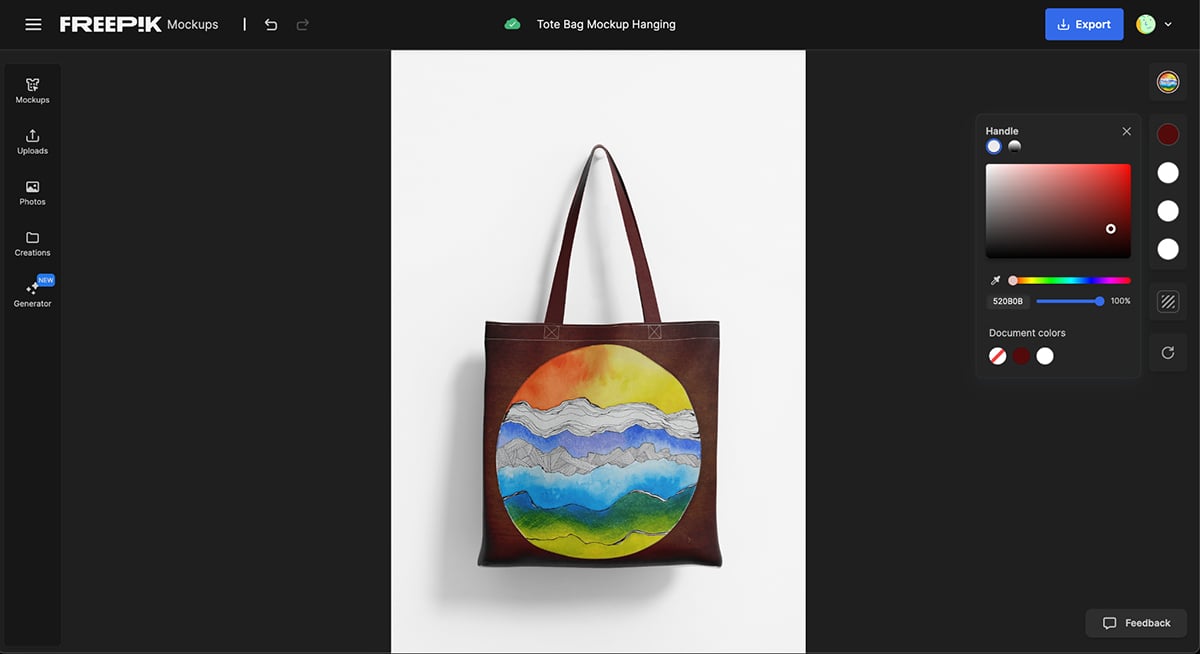
Like I mentioned before, Freepik also offers mockup templates in PSD file format for Photoshop. These aren’t editable online, but do include Smart Objects for easy editing with Adobe Photoshop. You have to download these to be able to use them.
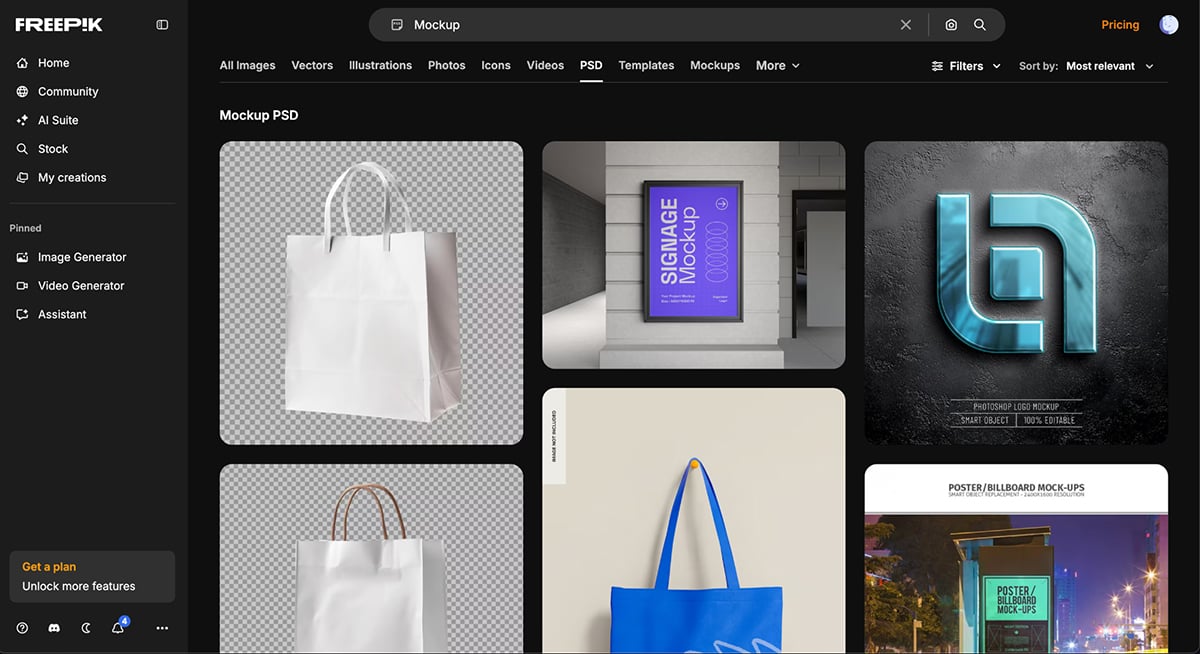
Freepik offers various pricing options for individuals and teams, with both monthly and annual billing plans.

G2 Rating: 3.7 /5 (95+ reviews)
PlaceIt started off as just an online mockup maker. When it was acquired by Envato, its list of design-related offers grew considerably. Regardless, they still offer plenty of mockup templates that you can edit online. Options include digital devices, merchandise, business cards, apparel and more.
The editor is simple enough to use, just upload your images and customize the options like background and card color. The color of the card will only change if you upload a transparent PNG. To test it out, I downloaded a business card design from Visme and uploaded it to PlaceIt.
This is what the editor looks like. They offer you other mockup options for the same content type on the right just in case you want to try something else.
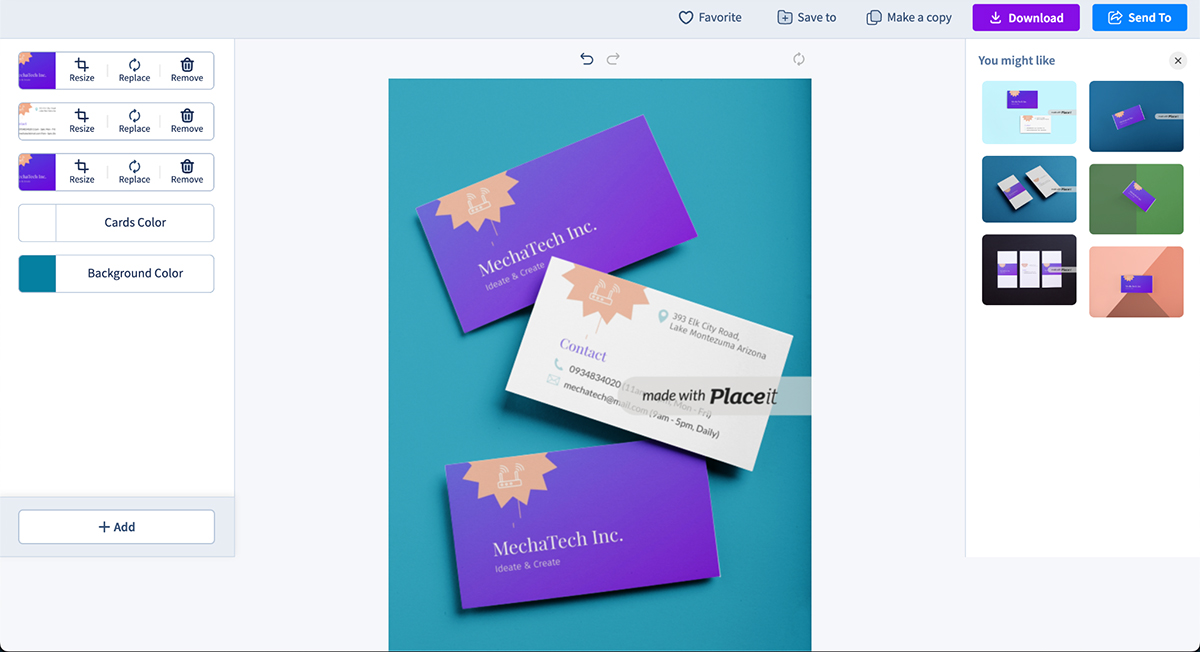
PlaceIt has only one plan and you get unlimited downloads.

G2 Rating: 4.6/5 (13150+ reviews)
Photoshop is a design tool from Adobe that allows you to manipulate every pixel of an image. And one of the things you can do with it, is create and edit mockups by merging layers and using Smart Objects.
The Smart Object feature makes it easy to change the image inside the mockup without much editing. To use mockups in Photoshop, you’ll have to download them from somewhere like Adobe Stock, Mr.Mockup or Creative Market.
In reality, the best part about using Photoshop for a mockup, isn’t just that Smart Objects make it easier. It’s the fact that you can edit the lighting, the angle or any little thing you want; as long as you have the skills of course.

While Photoshop does give you full control over your image, this amount of control comes at a hefty resource cost on your computer.
Because Photoshop is not cloud-based like Visme and Figma, your computer may not be able to run the program smoothly or even run at all.
You may want to check the specs on your hardware and see if your machine is up to the task of running Photoshop.
G2 Rating: N/A

As a mockup tool, Media Modifier is quite versatile. Not only can you edit mockups online, but they also offer options that many other websites don’t have. Plus, if they don’t have a mockup you need, you can submit the idea and they’ll consider creating it for you and adding it to the library.
I tested the Facebook post mockup and was surprised at how many options there were for customization and personalization of the design. Take a look:

Aside from social media mockups, they also offer several signage designs, candles, cosmetics and even an ATM.
Media Modifier is a great option if you don’t want to spend any money for a few mockups, or if you’re just trying out different tools.
Media Modifier offers a limited free plan and several paid plans with a 50% discount when paying yearly.
If you’re looking to optimize or simplify your mockup design creation, incorporate AI tools into the process. There are several ways you can achieve this. Some tools, like Freepik, will generate completely new mockups with AI, and Adobe Illustrator uses AI with its mockup tool add-on.
Designer Richard Carpenter published a great video on his YouTube channel about the Adobe Mockup Tool. In the video, he remarks, “The mockup tool in Illustrator makes it easier than ever to create stunning, realistic representations of your designs without needing to jump between different software.”
Other platforms, like Visme, offer supplemental features to help you make your mockup designs better. The AI Image Generator, for example, can create different types of visuals like photos, illustrations, graphics and more to accompany your mockup design.
Likewise, you can use Visme’s AI Designer to create different types of projects by uploading your content and then adding a saved mockup content block to the design.
To do this, first you create the mockup (there are instructions below) and then save it as a content block. Then, you generate a project and when editing, you place your saved mockup in the layout.
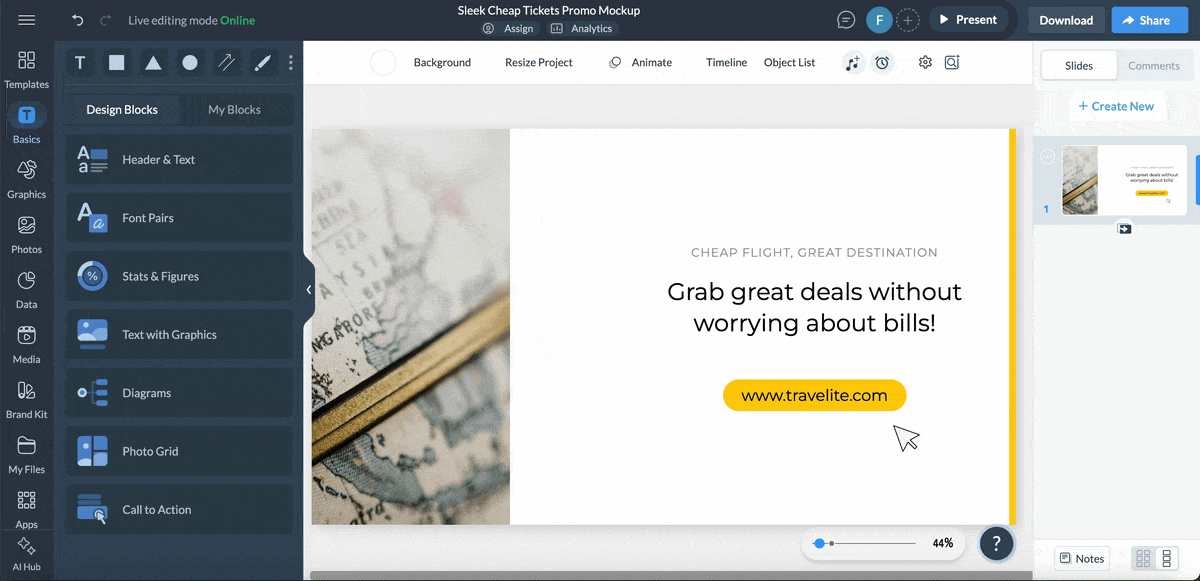
Finally, if you need support with the text in your mockup design or composition, try Visme’s AI Writer to craft catchy headlines or descriptive captions that will support your mockup.
After covering the basics of mockups, we'll now focus on the practical aspects. With Visme, you can easily create professional-looking mockups, even without a background in graphic design.
In this section, we will walk you through the process of making a mockup using Visme, from choosing a suitable template to adding your design and customizing the final result.
Here's a quick walkthrough on how to create a mockup with Visme.
Create a free account with Visme. With this free account, you will be able to access hundreds of professionally designed templates for several types of mockups.

Once you have created an account, you will be redirected to your Visme dashboard. This is where all of your future projects can be previewed, queried and shared. Click on the “Create New” button to begin making a new project. From the drop-down menu, select the type of visual you want to create. (If it's a mockup, you'll want to go to "More.")
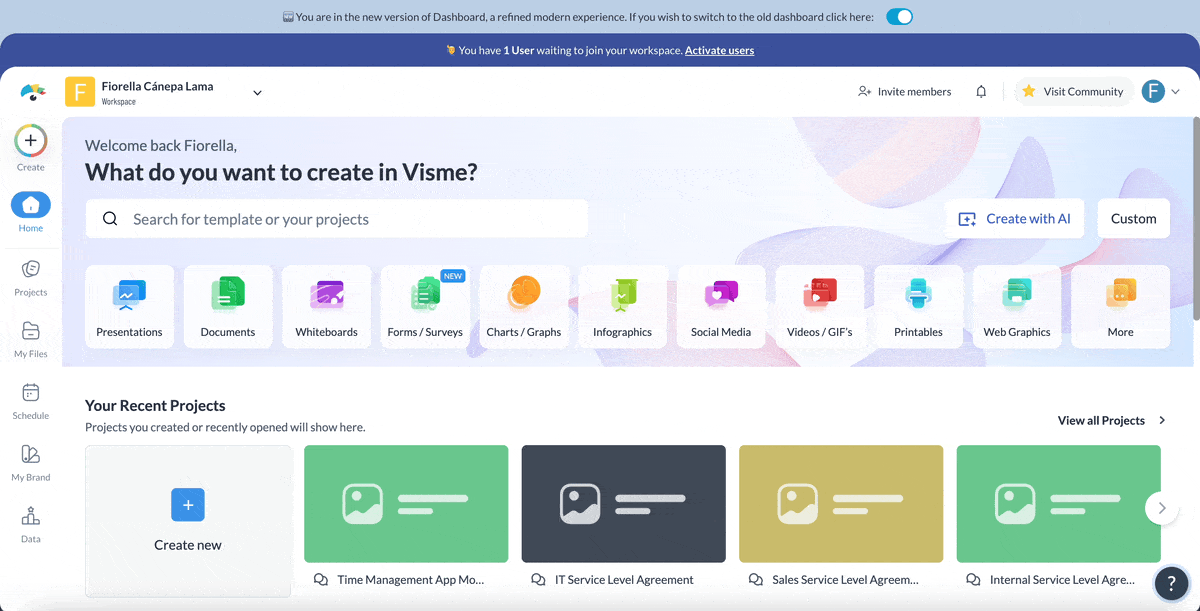
At the start of every new project, you can select an existing template crafted by professional designers or craft your own design and save it as a template for later use. To use an existing design, click on the mockup template that will best suit your needs and click “edit.”
Now, it's time to add your own design to the mockup.
If your design is ready, click on the "Photos" tab in the left sidebar, then click "Upload." Select your design file from your computer and upload it to Visme.
Once your design is uploaded, simply drag it from the "My Files" section onto the mockup area in the template. Visme will automatically adjust the perspective and scale of your design to fit the mockup.
If needed, you can further adjust the position, size, and rotation of your design within the mockup using the editing tools.

Visme offers several customization options to personalize your image mockup and make it truly unique. Here's how to put your personal touch on your template:
You can replace the default background with a solid color, gradient, image, or video. This feature allows you to create the perfect backdrop for your mockup.
To change the background, click the "Background" option on the top bar. From the drop-down menu, you can choose from many background types, including photos, gradients, videos and even animated ones. Choose a background type that matches your overall design.

Use the text tool to add captions, headlines or other text elements. Customize the fonts, colors and styles to match your branding, ensuring consistency across all your designs.
To add captions or headlines, go to the "Text" tab in the left sidebar. You can choose from preset text blocks like "Title," "Subtitle," or "Body Text" and drag your selection onto the mockup.
To edit the text, just double-click on the text box. You can customize the fonts, sizes and colors using the options in the top toolbar to match your branding.
Visme offers a wide selection of icons, illustrations and shapes that you can add to your mockup to enhance its visual appeal. This allows for creativity and makes your design stand out even more.
To incorporate graphics, navigate to the "Graphics" tab in the left sidebar. Browse or search for the elements that suit your design and drag them onto the mockup.
Once added, you can adjust their size, color and orientation using the editing tools in the toolbar.
Experiment with filters and effects to create a specific mood or atmosphere for your mockup. This step helps set the tone and make your presentation more compelling.
Lastly, to apply filters and effects to create a specific mood or atmosphere, select the image or graphic you wish to modify. A toolbar will appear; click the "Filter" button to explore various filter options, such as grayscale, sepia, brightness and contrast.
Choose the filter best suits your design, and use the slider tools to adjust its intensity until you achieve the desired effect.
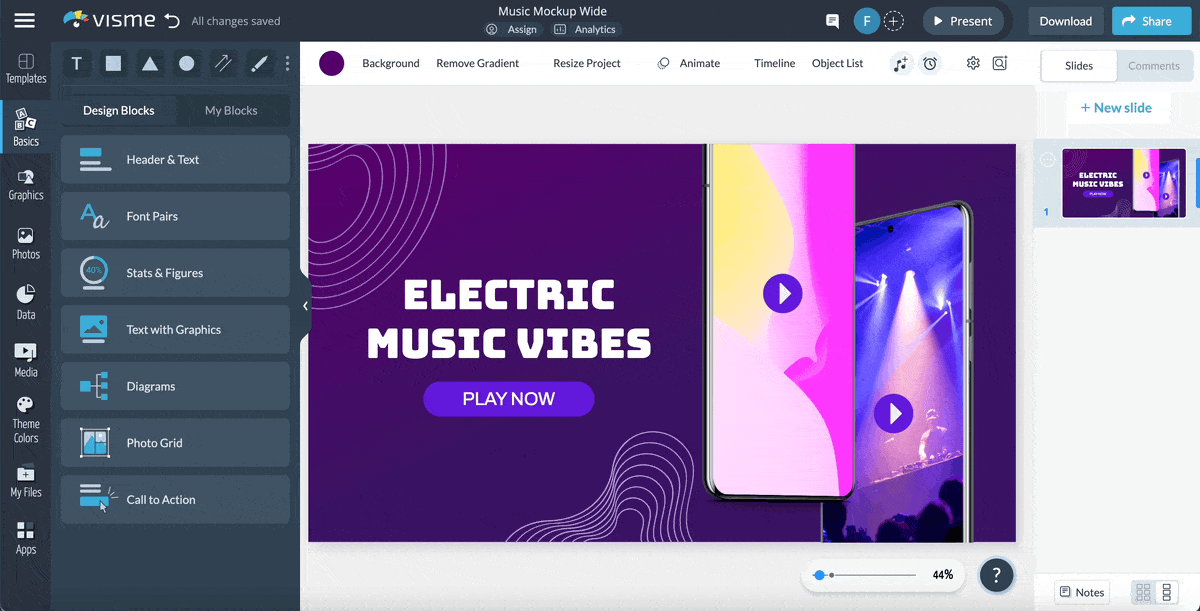
Once you're satisfied with your mockup, it's time to download or share it with others.
Click on the "Download" button in the top right corner and choose your preferred file format: JPG, PNG, PDF or HTML5.
You can also share your mockup directly from Visme by generating a shareable link or embedding it on your website or social media platforms.
For a more in-depth look at how to create mockups with Visme, check out this complete tutorial on how to create a mockup.
Aside from its ease of use, another key reason we recommend Visme is because of the seamless workflow it provides.
Visme creates a whole workspace where you can create a design, transform that design into a mockup and share your mockup for designers in various presentation forms with others.
Because Visme is such a versatile tool, or better said a complete workstation, with literally thousands of professional templates to choose from, Visme’s mockup generator makes the top of our list.

A sample is a physical representation of the real product, often used for testing or demonstration purposes. A mockup, on the other hand, is a non-functional visual representation that demonstrates the design and appearance of a product in a static form.
A mockup focuses primarily on the visual aspects of the product, showcasing its look and feel. While visually similar to a mockup, a prototype includes basic functionality to test interactions and user experience.
A 3D mockup shows a product in a realistic three-dimensional space. It helps designers and stakeholders evaluate the product’s physical attributes, appearance and possible manufacturing challenges.
Mockups come into the web design process after the wireframing stage. During wireframing, the basic layout and structure are defined. Mockups add visual elements like colors, images, and typography, bringing the design closer to its final appearance.
Creating mockups is important early in product development. They show the design idea physically so you can get feedback and make changes before spending money on prototypes or manufacturing.
A mockup pattern is a reusable template or framework that helps make it easier and faster to create mockups. It includes common UI elements, layouts, and styles, making designing consistent and visually appealing mockups easier. Visme offers a variety of mockup templates that can be customized to your needs.
Now that you know what mockups are and why they can be so important for business and marketing, it’s time for you to start creating one.
With Visme’s mockup generator, you can easily and quickly create mockups for your next project.
With hundreds of fully customizable mockup templates to choose from, we are certain you will find a mockup template that works for you and your needs.
Don’t wait another minute. Create your account for free and get started on your next mockup now.
Design visual brand experiences for your business whether you are a seasoned designer or a total novice.
Try Visme for free